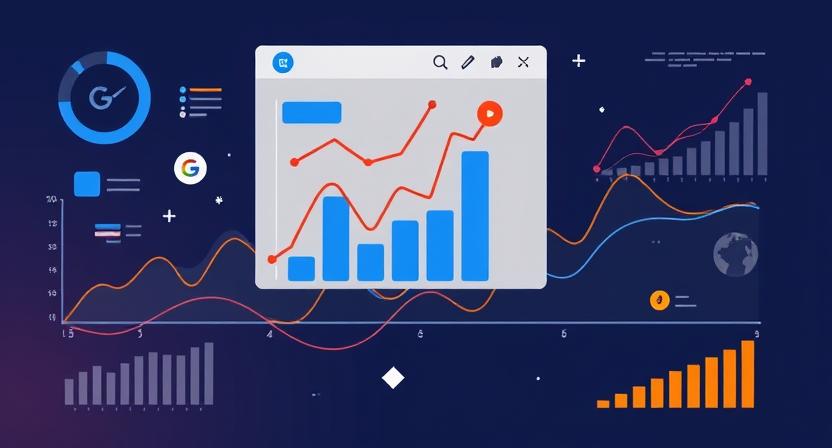If you’ve been digging into Google Analytics 4 (GA4), you’ve probably come across a traffic source called Cross-Network and thought what on earth does that mean?
I had the same question when I first saw it. After all, GA4 already has channels like Paid Search and Display. So why another one?
The answer is pretty interesting and very useful if you’re running modern Google Ads campaigns like Performance Max or Demand Gen. Let’s break it down in simple terms.
What is Cross-Network in GA4?
In GA4, Cross-Network is a traffic channel that groups users who arrive at your website via ads that run across multiple Google networks.
Google’s own definition is:
“Cross-network is the channel by which users arrive at your site/app via ads that appear on a variety of networks (e.g., Search and Display).”
Sounds a bit vague, right? So let’s put it in plain words:
Imagine you’re running a Performance Max campaign. Your ads don’t just appear in one place. They could show up on:
- Google Search results
- YouTube videos
- Gmail promotions tab
- Google Display Network (GDN)
- Google Discover feed
Since the campaign spans multiple placements, GA4 can’t neatly file it under just Search or Display. That’s why it introduces this new channel: Cross-Network.
So whenever you see traffic coming from Cross-Network in GA4, think of it as traffic from campaigns that run on multiple Google networks at the same time.
Why Did Google Introduce Cross-Network?
Back in Universal Analytics (UA), multi-network campaigns often got misclassified. For example, Performance Max traffic might have ended up under Paid Search or Display.
That was misleading because:
- You didn’t get a true picture of how those campaigns worked.
- Attribution got messy.
- Budget decisions were harder.
With GA4, Google wanted to make attribution more accurate. So, it created Cross-Network as a dedicated channel to keep things clean.
For us marketers, that means:
- Less confusion about where traffic is coming from.
- Easier comparison between campaign types.
- Better insights for budget allocation.
Which Campaigns Fall Under Cross-Network?
Currently, only two campaign types send traffic into the Cross-Network channel in GA4:
- Performance Max (P-Max)
- Runs across all Google channels (Search, Display, YouTube, Discover, Gmail).
- Uses Google’s AI to handle bidding, placements, and optimization.
- Automatically classified as Cross-Network.
- Demand Gen
- Runs across YouTube, YouTube Shorts, Discover, and Gmail.
- Focused on visual storytelling and demand creation.
- Also grouped under Cross-Network.
Note: Smart Shopping campaigns used to fall here too, but they were discontinued in 2022 and replaced by Performance Max.
Where to Find Cross-Network Data in GA4
If you’re running Performance Max or Demand Gen campaigns, here’s how you can check their performance in GA4:
- Open GA4 and go to Reports.
- Head to Acquisition > Traffic Acquisition.
- Look under the Default Channel Grouping column.
- You’ll see a row called Cross-Network.
From there, you can:
- Add secondary dimensions (like “Session campaign” or “Landing page”) to break down performance.
- Use the search bar in reports to filter for “cross-network” only.
You’ll also see Cross-Network appear in Advertising reports, especially the Attribution paths report. That’s super valuable because it shows you how these campaigns play a role in the whole conversion journey.
And if you’re into custom reporting? Head into Explorations you can slice and dice Cross-Network traffic however you like.
How to Use Cross-Network Data Effectively
Now, the big question: what do you do with this data? Here are some practical ways:
1. Track Multi-Platform Campaign Performance
Normally, if you’re running ads on Search, Display, YouTube, and Gmail, you’d have to open each campaign type separately and then try to stitch together how they’re doing. That’s messy and time-consuming.
Cross-Network in GA4 solves this by showing the combined performance of multi-channel campaigns like Performance Max or Demand Gen. Instead of looking at siloed reports, you see how everything is performing as one unified campaign. This gives you a true picture of impact not just search clicks or display impressions, but how the whole system works together.
2. Improve Budget Allocation
This is where it gets practical. Let’s say you notice that Cross-Network campaigns (like Performance Max) are generating better conversions compared to standalone Search or Display. That’s a clue. It tells you where your ad spend is driving more ROI.
So instead of blindly splitting budgets, you can shift more budget into campaigns that are working across networks. For example:
- If Performance Max is outperforming Search-only campaigns, you might reduce your Search budget slightly and push more into Performance Max.
- If Display-only isn’t converting but Demand Gen inside Cross-Network is, you put more weight there.
It’s about using data to fund the winners instead of treating every channel equally.
3. Refine Audience Targeting
Cross-Network data also tells you who’s actually engaging across different placements. For instance:
- Maybe you see that younger users engage more with your YouTube placements inside Performance Max.
- Or that a certain demographic clicks more on Gmail ads.
This insight helps you tweak your targeting. You can build custom segments or remarketing audiences from the best-performing users. Over time, you’re not just running ads everywhere you’re focusing on the audiences that respond best.
4. Enhance Attribution Accuracy
Here’s where GA4 is really helpful. In older analytics, a lot of these blended campaigns just showed up as “Paid Search” or “Display,” which made it tough to tell how they were actually helping the funnel.
Now, GA4 separates Cross-Network campaigns into their own category. That means:
- You get cleaner attribution models (no more lumping Performance Max into just “Search”).
- You can finally see how these campaigns contribute at different stages maybe they don’t always close the sale directly, but they help assist conversions by introducing users who later convert via Search or Direct.
This is powerful because it gives credit where it’s due. Instead of undervaluing your multi-channel campaigns, you can clearly see their role in the buyer journey.
How Does Cross-Network Differ from Other GA4 Channels?
Here’s a quick comparison table:
| Channel | What It Tracks | Example Campaigns |
|---|---|---|
| Paid Search | Ads shown on Google Search results only | Search campaigns |
| Display | Ads shown only on Google Display Network | Display campaigns |
| Cross-Network | Ads spanning multiple Google networks (Search + Display + YouTube + Discover + Gmail) | Performance Max, Demand Gen |
Important note: GA4 won’t double count traffic.
If a campaign is tagged as Cross-Network, its traffic will not also appear in Display or Paid Search.
How Does Cross-Network Attribution Work?
Google attributes users to Cross-Network based on:
- Campaign type (P-Max, Demand Gen)
- Ad interactions (clicks, engagement)
- User journeys tracked in GA4
Its models then plot where Cross-Network fits into the conversion path. For example:
- A user might see a P-Max ad on YouTube, then search for your brand, then convert.
- GA4 will assign part of that journey to Cross-Network, part to Paid Search.
This way, you get a holistic view of how multi-network ads influence conversions.
Benefits of Cross-Network in GA4
So, why should you actually care about this channel? Here are the main benefits:
1. Holistic Measurement
Think of Cross-Network as a big picture lens. Normally, Search, Display, and YouTube show up in different silos. But with Cross-Network, GA4 groups them into one channel. That means you’re measuring the campaign as a whole not just one piece of it.
For campaigns like Performance Max or Demand Gen, which are designed to run across multiple placements, this is super useful. Instead of getting lost in fragmented numbers, you finally see how the entire multi-channel strategy is performing.
2. Simpler Reporting
Before GA4 introduced Cross-Network, marketers had to manually stitch together data from different campaign types. Example: pulling Display clicks, Search conversions, and YouTube views separately, then trying to make sense of it in Excel.
Now? All of that rolls up into one clean report. No more spreadsheets or double-counting. Reporting gets faster, cleaner, and easier to explain to clients or stakeholders.
3. Better Comparisons
This one is underrated. With Cross-Network as a separate channel, you can benchmark it against your other traffic sources like Paid Search, Organic, or Social.
So if Cross-Network drives conversions at a lower CPA than Paid Social, that’s a clear win. Or if your ROAS from Performance Max lags behind Search-only campaigns, you’ll know it needs tweaking.
Basically, it gives you a fair playing field to compare channels instead of guessing how multi-channel campaigns stack up.
4. Smarter Budgeting
This is where the money side comes in. By seeing performance data in one place, you can make better budget allocation decisions.
- If Performance Max consistently beats Search-only in terms of ROAS, you shift more budget there.
- If Demand Gen underperforms Display-only, maybe you cap its spend.
Instead of splitting ad spend blindly, you’re investing where the data says the best returns are.
5. Performance Insights
At the end of the day, marketers want answers to questions like:
- What’s my cost per acquisition (CPA)?
- What’s my return on ad spend (ROAS)?
- Which audience or placement is driving the most engagement?
Cross-Network data gives you these insights from a multi-channel perspective. It’s not just “Search gave me X leads” or “YouTube gave me Y views.” It’s: “When all channels work together, here’s the real performance.”
That clarity helps you optimize campaigns smarter whether it’s refining targeting, adjusting creatives, or reallocating spend.
Wrapping Up
Cross-Network in GA4 might sound confusing at first, but once you understand it, it’s actually a big win for marketers.
It gives you a dedicated view of multi-platform campaigns like Performance Max and Demand Gen something that was messy in Universal Analytics.
The key takeaway is this:
- Display = Display-only campaigns.
- Paid Search = Search-only campaigns.
- Cross-Network = Multi-network campaigns like P-Max and Demand Gen.
By monitoring this channel closely, you’ll be able to:
- Make smarter ad spend decisions
- Improve attribution accuracy
- Optimize your campaigns with confidence
And remember while Cross-Network simplifies things, it’s just the starting point. If you want deeper insights, break it down further in GA4 reports and explorations. That’s where the real gold lies.


